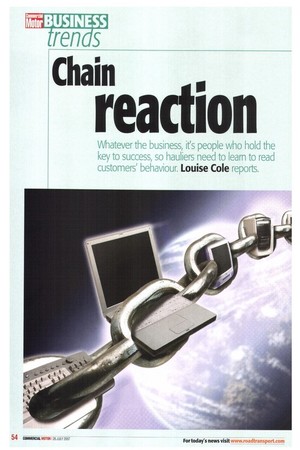Chain
Page 54

Page 55

If you've noticed an error in this article please click here to report it so we can fix it.
reach on
Logistics is not about trucks or the movement of goods; according to business guru John Gattoma it is about the behaviour of people.And, he says, if more logistics and transport companies realised this, they would make more money.
Gattorna, who has written several books on supply chain management, says the first realisation all business people must make is that the supply chain is their business. It's not just important, it is central. It doesn't matter what you produce, or who you sell to; the business occurs when the goods or information is delivered."Every organisation is filled with internal supply chains as well," says Gattoma.
The first key to designing your firm's workload has to be theory. Gattorna acknowledges that this is unpopular among lots of down-to-earth business people but insists: "There's nothing so practical as a good theory. The best executives have a good theory behind what they are doing."
He also warns against trying to treat all customers in the same way:"We know life is getting more complex and it's become like a bowl of spaghetti. Increasingly managers compromise on the lowest common denominator-`let's standardise across operations, across customers'. But that decreases the alignment between you and individual customers."
Streamlined and effective
Alignment is a logistics buzzword it means how streamlined and effective the service you deliver is and how closely it meshes with the customers' needs."Canadian geese fly in formation with a leader in front and 'honkers' on the outside wings. They can fly like this five times as far as a single goose can on its own. That's alignment," says Gattoma.
The key to keeping yourself aligned with all customers, he insists, is to realise that the infrastructure of logistics -the trucks, the warehouses, the delivery points are simply 'enablers'.The key is the people:" People making decisions, people behaving that's what moves things. A customer decides how to behave towards your firm and a member of your organisation responds," Learning how to read customer behaviour and making sure the response is appropriate and properly priced is therefore crucial to business success.
Gattoma suggests that the first step for any transport company is to organise its people into productive teams: "Organisational design is the biggest problem in logistics. Not putting the right people together in the right way." He cites the Myers Briggs analysis tools that allow managers and employees to assess their strengths and tendencies with the result that people can be combined to complement one another's skill sets and not replicate them.
For instance, identifying those people who are natural problem solvers or ideas generators and coupling them with people who are good at evaluation and attention to detail is more effective than putting two 'ideas people' together.
But Gattorna says we should not only evaluate our staff; the real money is in evaluating our customers."There are patterns to human behaviour. If you understand the pattern you can plan rather than react," he says."The analysis tools we can use on individuals can also be used to describe groups or companies."
Customer categorisation
Gattoma suggests that while we may categorise employees into groups such as feeling (teamwork, cohesion, relationships);intuition (development, creativity); sensing (analysis, systems control); or thinking (energy, action, results), there are other useful categories for customers.
He has identified four dominant behaviours: • 'Collaborative' customers "want to work together to mutual benefit"they communicate clearly and want to build a regular relationship with the firm with strong loyalty.
• 'Efficient' clients are looking for regular, consistent and low-cost service.
• 'Dynamic' clients require rapid response services for an unpredictable supply.
• 'Innovative' clients want you to offer a bespoke service, problem solving on their behalf.
All these people can offer good money. but you need to assess which is which to manage your resources effectively and to charge them the right price. -The problem is that companies undervalue the collaborative customers and [abuse their loyalty when they chase big new business in the dynamic sector," Gattorna warns.
In other words, too often resource is pulled away from the loyal steady customers to impress potentially big accounts but the chances are they won't ever reward you with loyalty or steady income.
It is not a problem to chase dynamic or innovative custom; just be sure you charge the right price.
Get the price right
If people require a rapid response, or a bespoke solution they ought to be paying for it.A much higher rate is needed to justify your last-minute scrambling of trucks, or the re-arrangement of other customers' loads. And don't make the mistake of thinking all business needs to be won by offering the lowest price: "Lean is not going to save the world.There are still customers who are willing to pay for innovation and service," he says.
And if they are not willing to pay for it, ask yourself if you are going to make enough money out of them to justify not being able to plan the way you can with other clients: "Some clients are demanding SOBs --'respond to me!' they say. If you can service them you'll have to make lots of adjustments to your [working pattern] to do it and you must charge them a premium."
So forget one price, or one service, fits all, and forget trying to offer the lowest price you can. Understand the nature of the customer and what dominates the kind of service they will demand and it could revolutionise the way you do business.
As Gattorna puts it"If you understand where you are under-servicing some and overservicing others, you can reallocate resource and raise customer satisfaction without increasing costs."
• For more on John Gattornals theories see www.johngattorna.com
























































































































































































